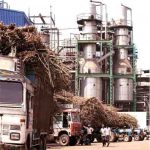The sugar industry continues to struggle to generate adequate revenue and savings on a continuous basis. Several sugar companies are under financial stress mainly because of a very high sugarcane price and a very high sugar inventory, which is blocking lot of sugar millers’ working capital.
While addressing the 86th Annual General Meeting of Indian Sugar Mills Association (ISMA), Mr. Vivek Pittie, President ISMA shared his views on the Current Scenario of the Indian Sugar Industry.
Sugarcane Pricing Policy
The basic problem that our industry is facing, is the sugarcane pricing policy, which is totally different to what the other sugar producing nations follow in their countries. The problem comes up when India has to compete with the major sugar producing nations like Brazil, Thailand, Australia, EU, Russia etc., which have the revenue sharing formula to determine the sugarcane price automatically, at 62-66% of revenue realization from sugar and by-products. On the other hand, India’s sugarcane price being fixed by the Government, is not related to the revenue realization, thus making India a high-cost producer of sugar.
Ethanol Production & Blending with Petrol
The industry has responded very well, and in the last 2 years, we have achieved 5% ethanol blending on an average across the country. In some States, we have even blended upto 9.5% with petrol. The industry is extremely keen on developing more ethanol production capacities, but due to delay in sanctioning of loans by the banks, the investment is slow. Banks are still not giving ethanol projects the priority they deserve, especially when the Government including the Hon’ble Prime Minister, give the programme so much importance.
There is need to have some kind of standards or norms set for the banks on interest rates, tenure of loans, collateral security percentage, debt-equity ratio etc. if we want the investments to happen fast. In addition to delay in loan sanctioning, there is delay in giving environment clearances. There are suggestions being given by the Independent Committee of the Government in the Environment Ministries, in the Centre and in the States, which are not in tune with the Government approved policies or the approvals given by the Central Pollution Control Board. To make the process faster, ISMA has also given several suggestions on how to reduce the total time period from the current average 16 months to 8 months.
There is, however, one pending request with respect to ethanol pricing policy or the ethanol pricing formula being put in public domain by the Government. The bankers, investors, suppliers etc. will get more confidence in the programme once they see the transparent ethanol pricing formula which the Government uses to fix ethanol price every year. We would request the Government that the ethanol pricing formula be put in the public domain.
By-products and Revenue Realisation from thereof
The sugar industry would be the most unique industry where everything which comes out of sugarcane is fully utilized not only to make sugar, but several other by products including power, alcohol, ethanol, bio-fertiliser, biogas, bio CBG and recently potash pellets etc. The water we get from the sugarcane is also fully utilized by us for our sugar processing, including for cleaning of plant and machinery etc. Beyond that, we get another 100 litres of water per ton of sugarcane crushed, which is surplus to our factory requirement, which we treat and bring it down to usable level and give to the farmers for their irrigation purpose. Sugar industry is, therefore, a unique industry which is a net generator of water. Even after value addition to all the by products, which is done at a very efficient level, sugar continues to be the most important product and contributes for 75-80% of the total revenue generation. With higher quantity of sugarcane juice now getting diverted into ethanol, the 75 to 80% contribution from sugar may come down slightly, but we still need to remember that sugar will continue to always be the most important product.
The latest is our effort to utilize fly ash from our incineration boilers, to trap the potash and make potash pellets for use as fertilizer. We are proud that we responded very strongly and immediately to the country’s requirement when the COVID-19 pandemic started spreading in India, by setting up capacities across the country to produce hand sanitizers in bulk. There was absolutely no shortage of hand sanitizers in the country as well as their price remained under control which was because of the quick response by the sugar industry.
Pending Policy Decisions which are causing problem to the sugar industry
The first very important pending matter is with regard to the Minimum Selling Price (MSP) of sugar which has been revised only once and that was way back in February 2019 to Rs. 31 per kilo. Over 22 months have passed since then, but the MSP has not been revised. This is despite the fact that the Government has increased the FRP for sugarcane from October 2020. NITI Aayog in its report of April 2020 has also recommended for an increase in the MSP, to Rs. 33 per kilo. Several States, including U.P. Maharashtra, Karnataka, Bihar etc. have also requested for the MSP increase to Rs. 33 to 36 per kilo, arguing that otherwise sugarcane price will not be paid on time. These recommendations for increase in MSP are not because of inflation, but because of the aberration in the calculation of costs as also because of the recent increase in sugarcane price fixed by the Government from Oct. 2020.The WPI weightage for sugar, which was 3.6% about a decade back, is just 1.06%now, and therefore, the above increase will not have any significant impact on WPI, as much as it used to have about 12-13 years back.
65% of annual consumption in India is by bulk consumers and, therefore, the benefit of lower ex-mill price or MSP is taken by such large business houses. It does not get passed on to the consumers, by reduction in the price of their products. It is important to note that about 2-3 years back, the ex-mill prices were Rs. 34-35 per kilo and there were absolutely no issues with the consumers or households. A family of 4-5 members consume about 4-5 kilos of sugar a month, and therefore, a 2-3 rupees increase in the sugar price, increases the household budget by just Rs.10-15 per month only. But what it does is it ensures that our farmers get a remunerative price for sugarcane on time, without burdening our household budgets.
Secondly, during the last two sugar seasons the Government has created buffer stock of 30 lac and 40 lac tons, respectively, under which the carrying cost is reimbursed by the Government, provided sugar mills do not sell the buffer stock created by them. This removes 30-40 lac tons from the market and improves market sentiments, as well as reduces the pressure on sugar mills to sell that quantity of sugar. We believe that a proposal to create 40 lac tons of buffer stock for current 2020-21 sugar season is pending for decision by the CCEA.”
Pittie concluded saying,“I wish to acknowledge with deep sense of gratitude the positive policy decisions and financial assistance that the sugar sector has received with regard to the approval of 60 lac tons of sugar exports with Rs.3,500 crore of export subsidy and second is the budgetary allocation of Rs. 5,300 crore finally received by Food Ministry for payment of past subsidies.
The long term solution to tackle surplus sugar and to make the sugar industry truly “atmanirbhar”, is to rationalize policies on sugarcane, by giving the right price signals to the farmers. Those should include reforms in sugarcane pricing policy as also encouraging diversion of surplus sugarcane into ethanol by continuing with the policy of differential pricing of ethanol manufactured from different feedstocks. We should not adopt any ad-hoc schemes with any temporary intention to discourage plantation of sugarcane in the unfounded hope to reduce sugarcane area, because these policies do not work well and would in fact harm the sector in the long run, especially when we are trying to produce more ethanol from sugarcane.”












